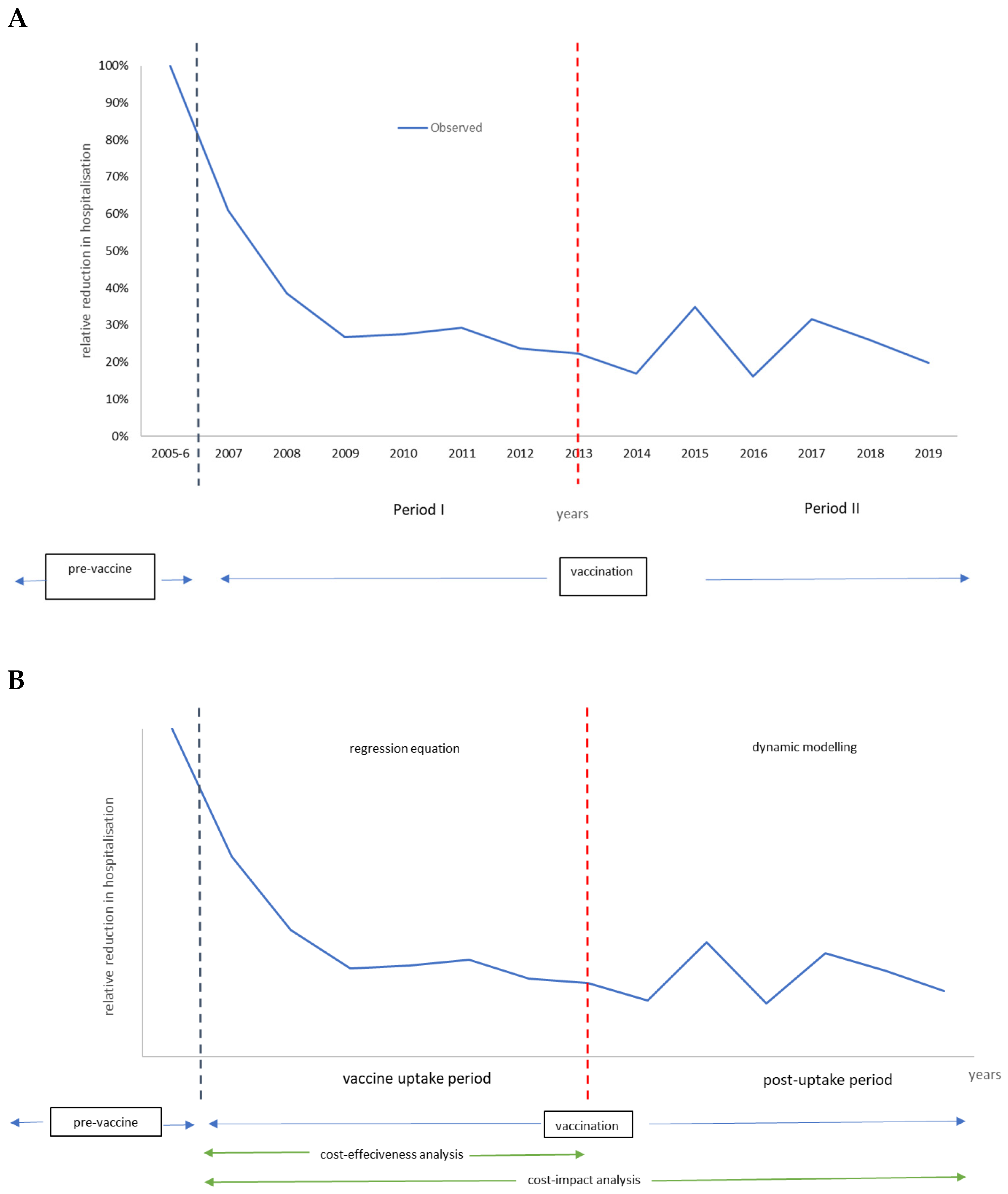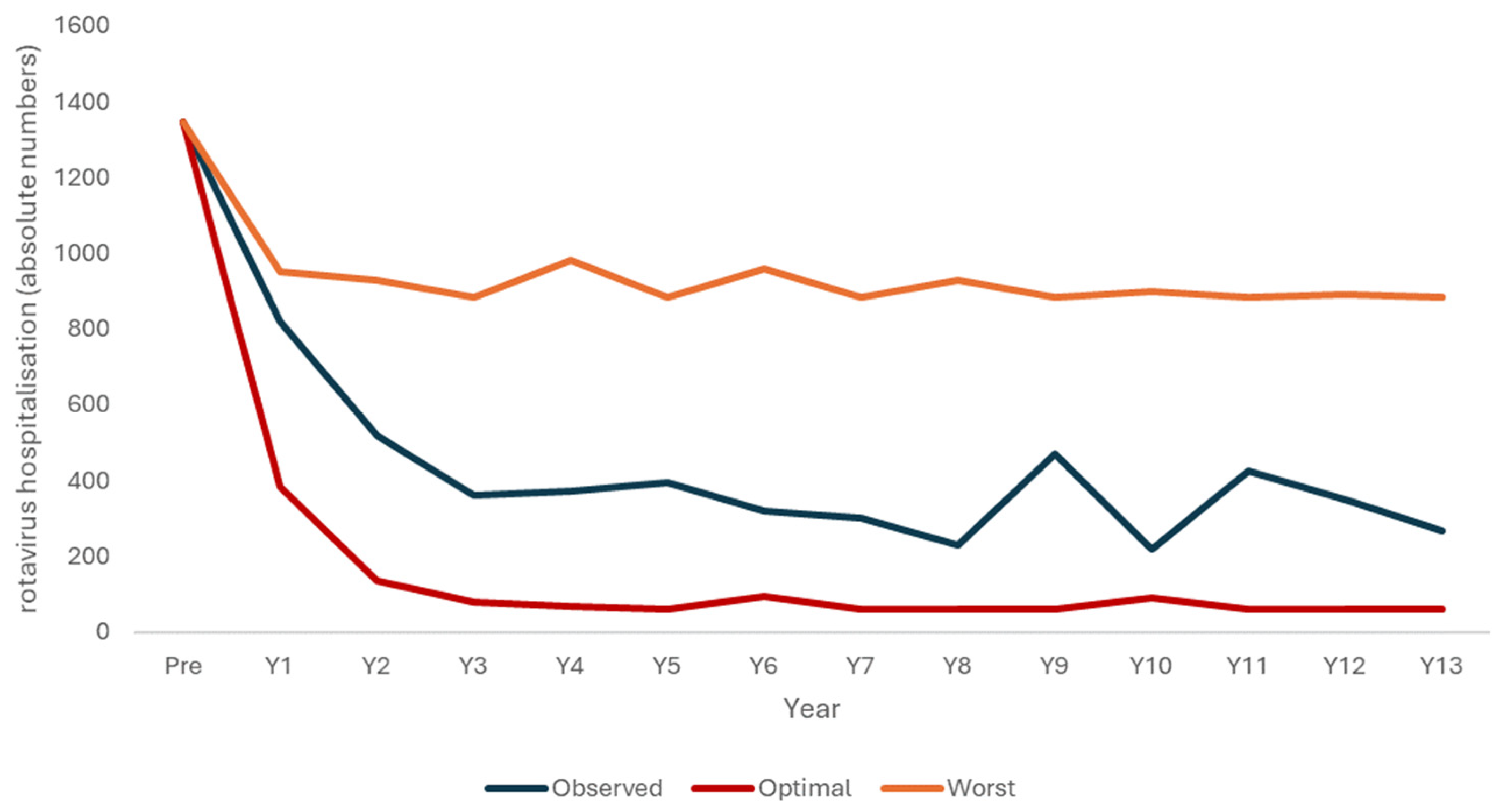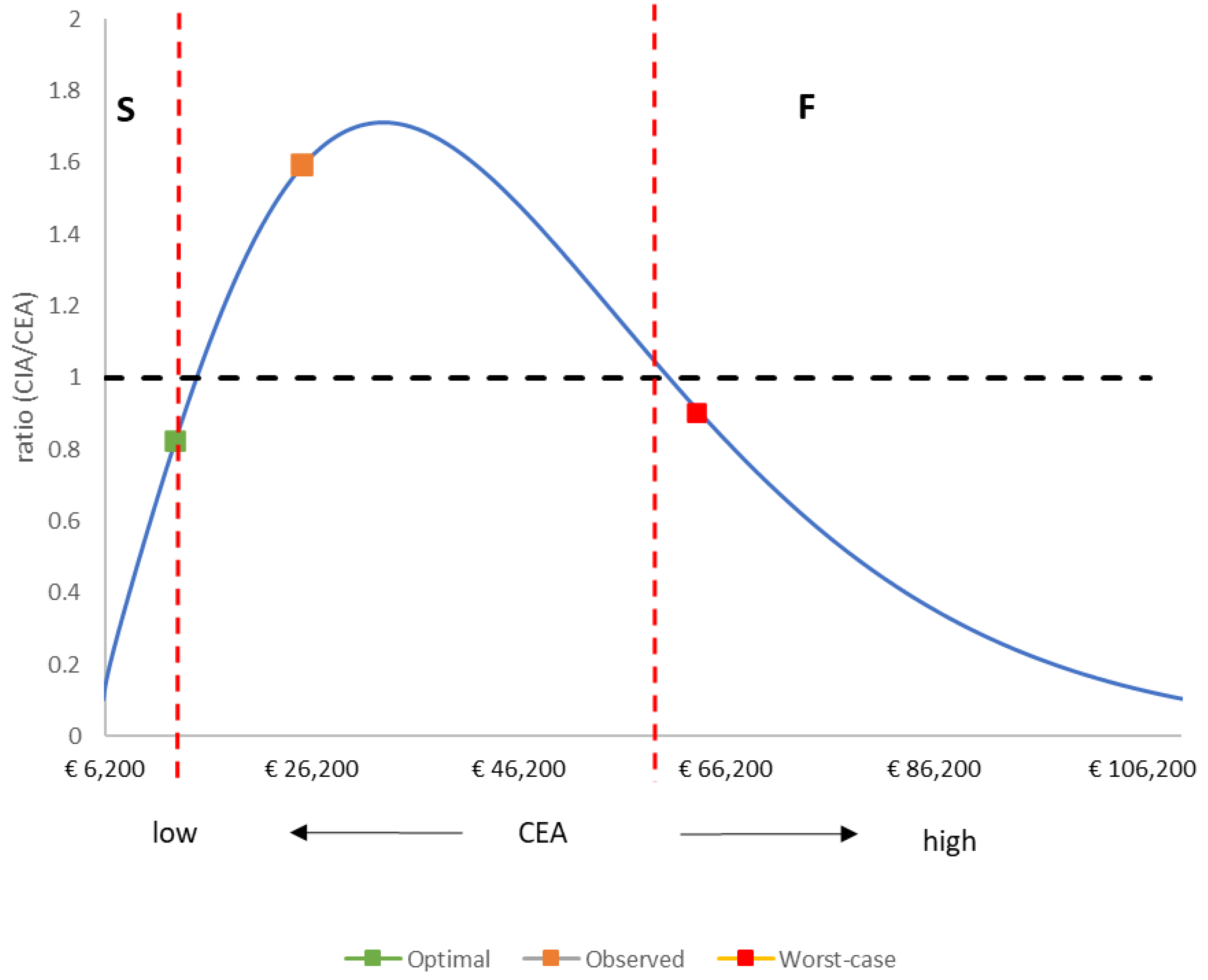Measuring the Vaccine Success Index: A Framework for Long-Term Economic Evaluation and Monitoring in the Case of Rotavirus Vaccination
Abstract
1. Introduction
2. Materials and Methods
2.1. Background
2.2. Economic Assessment
2.2.1. Data
2.2.2. Modeling
2.3. Cost-Effectiveness and Cost-Impact Analysis
2.3.1. Input Data
2.3.2. Output Data
2.4. The Success Index
3. Results
3.1. ICER Results
3.2. The Success Index and the Scenario Analyses
4. Discussion
5. Conclusions
Author Contributions
Funding
Institutional Review Board Statement
Informed Consent Statement
Data Availability Statement
Acknowledgments
Conflicts of Interest
References
- Halloran, M.E.; Longini, I.M.; Struchiner, C.J. Design and Analysis of Vaccine Studies; Gail, M., Krickeberg, K., Samet, J., Tsiatis, A., Wong, W., Eds.; Springer: New York, NY, USA; Dordrecht, The Netherlands; Berlin/Heidelberg, Germany; London, UK, 2010; 387p. [Google Scholar]
- Halloran, M.E.; Longini, I.M., Jr.; Struchiner, C.J. Design and interpretation of vaccine field studies. Epidemiol. Rev. 1999, 21, 73–88. [Google Scholar] [CrossRef] [PubMed]
- Halloran, M.E.; Longini, I.M., Jr.; Struchiner, C.J. Estimability and interpretation of vaccine efficacy using frailty mixing models. Am. J. Epidemiol. 1996, 144, 83–97. [Google Scholar] [CrossRef] [PubMed]
- Ray, G.T.; Lewis, N.; Klein, N.P.; Daley, M.F.; Wang, S.V.; Kulldorff, M.; Fireman, B. Intraseason Waning of Influenza Vaccine Effectiveness. Clin. Infect. Dis. 2019, 68, 1623–1630. [Google Scholar] [CrossRef] [PubMed]
- Tokars, J.I.; Patel, M.M.; Foppa, I.M.; Reed, C.; Fry, A.M.; Ferdinands, J.M. Waning of Measured Influenza Vaccine Effectiveness Over Time: The Potential Contribution of Leaky Vaccine Effect. Clin. Infect. Dis. 2020, 71, e633–e641. [Google Scholar] [CrossRef] [PubMed]
- Lipsitch, M. Challenges of Vaccine Effectiveness and Waning Studies. Clin. Infect. Dis. 2019, 68, 1631–1633. [Google Scholar] [CrossRef]
- Standaert, B.; Benninghoff, B. Defining the Recipe for an Optimal Rotavirus Vaccine Introduction in a High-Income Country in Europe. Viruses 2022, 14, 425. [Google Scholar] [CrossRef]
- Hanquet, G.; Valenciano, M.; Simondon, F.; Moren, A. Vaccine effects and impact of vaccination programmes in post-licensure studies. Vaccine 2013, 31, 5634–5642. [Google Scholar] [CrossRef]
- Standaert, B. The economic value of rotavirus vaccination when optimally implemented in a high-income country. Vaccines 2023, 11, 917. [Google Scholar] [CrossRef]
- Standaert, B.; Dort, T.; Toumi, M. Vaccine Efficacy, Effectiveness, or Impact: Which One to Choose in Economic Evaluations of Vaccines? Value Health 2017, 20, PA754. [Google Scholar] [CrossRef]
- Standaert, B.; Strens, D.; Pereira, P.; Benninghoff, B.; Raes, M. Lessons Learned from Long-Term Assessment of Rotavirus Vaccination in a High-Income Country: The Case of the Rotavirus Vaccine Belgium Impact Study (RotaBIS). Infect. Dis. Ther. 2020, 9, 967–980. [Google Scholar] [CrossRef]
- Standaert, B.; Strens, D.; Raes, M.; Benninghoff, B. Explaining the formation of a plateau in rotavirus vaccine impact on rotavirus hospitalisations in Belgium. Vaccine 2022, 40, 1948–1957. [Google Scholar] [CrossRef] [PubMed]
- Carrico, J.; Mellott, C.E.; Talbird, S.E.; Bento-Abreu, A.; Merckx, B.; Vandenhaute, J.; Benchabane, D.; Dauby, N.; Ethgen, O.; Lepage, P.; et al. Public health impact and return on investment of Belgium’s pediatric immunization program. Front. Public Health 2023, 11, 1032385. [Google Scholar] [CrossRef] [PubMed]
- Standaert, B.; Harlin, O.; Desselberger, U. The financial burden of rotavirus disease in four countries of the European Union. Pediatr. Infect. Dis. J. 2008, 27, S20–S27. [Google Scholar] [CrossRef]
- Velazquez, F.R.; Matson, D.O.; Calva, J.J.; Guerrero, L.; Morrow, A.L.; Carter-Campbell, S.; Glass, R.I.; Estes, M.K.; Pickering, L.K.; Ruiz-Palacios, G.M. Rotavirus infection in infants as protection against subsequent infections. N. Engl. J. Med. 1996, 335, 1022–1028. [Google Scholar] [CrossRef]
- Crawford, S.E.; Ramani, S.; Tate, J.E.; Parashar, U.D.; Svensson, L.; Hagbom, M.; Franco, M.A.; Greenberg, H.B.; O’Ryan, M.; Kang, G.; et al. Rotavirus infection. Nat. Rev. Dis. Primers 2017, 3, 17083. [Google Scholar] [CrossRef]
- van Gaalen, R.D.; van de Kassteele, J.; Hahne, S.J.M.; Bruijning-Verhagen, P.; Wallinga, J. Determinants of Rotavirus Transmission: A Lag Nonlinear Time Series Analysis. Epidemiology 2017, 28, 503–513. [Google Scholar] [CrossRef]
- Poelaert, D.; Pereira, P.; Gardner, R.; Standaert, B.; Benninghoff, B. A review of recommendations for rotavirus vaccination in Europe: Arguments for change. Vaccine 2018, 36, 2243–2253. [Google Scholar] [CrossRef]
- Bencina, G.; Costantino, C.; Mameli, C.; Sabale, U. Real-world impact of rotavirus vaccination in European healthcare settings: A systematic literature review. Expert Rev. Vaccines 2022, 21, 1121–1136. [Google Scholar] [CrossRef]
- Pereira, P.; Vetter, V.; Standaert, B.; Benninghoff, B. Fifteen years of experience with the oral live-attenuated human rotavirus vaccine: Reflections on lessons learned. Expert Rev. Vaccines 2020, 19, 755–769. [Google Scholar] [CrossRef]
- Vesikari, T.; Matson, D.O.; Dennehy, P.; Van Damme, P.; Santosham, M.; Rodriguez, Z.; Dallas, M.J.; Heyse, J.F.; Goveia, M.G.; Black, S.B.; et al. Safety and efficacy of a pentavalent human-bovine (WC3) reassortant rotavirus vaccine. N. Engl. J. Med. 2006, 354, 23–33. [Google Scholar] [CrossRef]
- Vesikari, T.; Karvonen, A.; Prymula, R.; Schuster, V.; Tejedor, J.C.; Cohen, R.; Meurice, F.; Han, H.H.; Damaso, S.; Bouckenooghe, A. Efficacy of human rotavirus vaccine against rotavirus gastroenteritis during the first 2 years of life in European infants: Randomised, double-blind controlled study. Lancet 2007, 370, 1757–1763. [Google Scholar] [CrossRef] [PubMed]
- Koch, J.; Harder, T.; von Kries, R.; Wichmann, O. Risk of Intussusception After Rotavirus Vaccination. Dtsch. Arztebl. Int. 2017, 114, 255–262. [Google Scholar] [CrossRef] [PubMed]
- Ledent, E.; Arlegui, H.; Buyse, H.; Basile, P.; Karkada, N.; Praet, N.; Nachbaur, G. Benefit Versus Risk Assessment of Rotavirus Vaccination in France: A Simulation and Modeling Analysis. BioDrugs 2018, 32, 139–152. [Google Scholar] [CrossRef] [PubMed]
- Jit, M.; Bilcke, J.; Mangen, M.J.; Salo, H.; Melliez, H.; Edmunds, W.J.; Yazdan, Y.; Beutels, P. The cost-effectiveness of rotavirus vaccination: Comparative analyses for five European countries and transferability in Europe. Vaccine 2009, 27, 6121–6128. [Google Scholar] [CrossRef] [PubMed]
- Standaert, B.; Strens, D.; Alwan, A.; Raes, M. Medium- to Long-Term Impact of Rotavirus Vaccination on Hospital Care in Belgium: A 7-Year Follow-Up of the Rotavirus Belgium Impact Study (RotaBIS). Infect. Dis. Ther. 2016, 5, 31–44. [Google Scholar] [CrossRef]
- Standaert, B.; Strens, D.; Li, X.; Schecroun, N.; Raes, M. The Sustained Rotavirus Vaccination Impact on Nosocomial Infection, Duration of Hospital Stay, and Age: The RotaBIS Study (2005–2012). Infect. Dis. Ther. 2016, 5, 509–524. [Google Scholar] [CrossRef]
- Raes, M.; Strens, D.; Vergison, A.; Verghote, M.; Standaert, B. Reduction in pediatric rotavirus-related hospitalizations after universal rotavirus vaccination in Belgium. Pediatr. Infect. Dis. J. 2011, 30, e120–e125. [Google Scholar] [CrossRef]
- Vynnycky, E.; White, R. An Introduction to Infectious Disease Modelling; Oxford University Press: Oxford, UK, 2010. [Google Scholar]
- Chua, H.; Feng, S.; Lewnard, J.A.; Sullivan, S.G.; Blyth, C.C.; Lipsitch, M.; Cowling, B.J. The Use of Test-negative Controls to Monitor Vaccine Effectiveness: A Systematic Review of Methodology. Epidemiology 2020, 31, 43–64. [Google Scholar] [CrossRef]
- Bilcke, J.; Beutels, P.; De Smet, F.; Hanquet, G.; Van Ranst, M.; Van Damme, P. Kosten-Effectiviteitsanalyse van Rotavirus Vaccinatie van Zuigelingen in België; Federaal Kenniscentrum voor de Gezondheidszorg (KCE): Brussels, Belgium, 2007.
- Martin, A.; Cottrell, S.; Standaert, B. Estimating utility scores in young children with acute rotavirus gastroenteritis in the UK. J. Med. Econ. 2008, 11, 471–484. [Google Scholar] [CrossRef]
- Atkins, K.E.; Shim, E.; Pitzer, V.E.; Galvani, A.P. Impact of rotavirus vaccination on epidemiological dynamics in England and Wales. Vaccine 2012, 30, 552–564. [Google Scholar] [CrossRef]
- Atchison, C.; Lopman, B.; Edmunds, W.J. Modelling the seasonality of rotavirus disease and the impact of vaccination in England and Wales. Vaccine 2010, 28, 3118–3126. [Google Scholar] [CrossRef] [PubMed]
- Gower, C.M.; Stowe, J.; Andrews, N.J.; Dunning, J.; Ramsay, M.E.; Ladhani, S.N. Sustained Declines in Age Group-Specific Rotavirus Infection and Acute Gastroenteritis in Vaccinated and Unvaccinated Individuals During the 5 Years Since Rotavirus Vaccine Introduction in England. Clin. Infect. Dis. 2022, 74, 437–445. [Google Scholar] [CrossRef] [PubMed]
- Leino, T.; Baum, U.; Scott, P.; Ollgren, J.; Salo, H. Impact of five years of rotavirus vaccination in Finland—And the associated cost savings in secondary healthcare. Vaccine 2017, 35, 5611–5617. [Google Scholar] [CrossRef] [PubMed]
- Ruiz-Contreras, J.; Alfayate-Miguelez, S.; Carazo-Gallego, B.; Onis, E.; Diaz-Munilla, L.; Mendizabal, M.; Mendez Hernandez, M.; Ferrer-Lorente, B.; Unsain-Mancisidor, M.; Ramos-Amador, J.T.; et al. Rotavirus gastroenteritis hospitalizations in provinces with different vaccination coverage rates in Spain, 2013–2018. BMC Infect. Dis. 2021, 21, 1138. [Google Scholar] [CrossRef] [PubMed]
- Health Protection Surveillance Centre. Annual Reports on Rotavirus. Available online: https://www.hse.ie/eng/health/immunisation/hcpinfo/othervaccines/rotavirus/#How%20many%20cases%20of%20rotavirus%20occur%20in%20Ireland? (accessed on 20 May 2021).
- Hanquet, G.; Ducoffre, G.; Vergison, A.; Neels, P.; Sabbe, M.; Van Damme, P.; Van Herck, K. Impact of rotavirus vaccination on laboratory confirmed cases in Belgium. Vaccine 2011, 29, 4698–4703. [Google Scholar] [CrossRef]
- Standaert, B. How to design an optimal vaccine launch. Res. Features 2023, 148, 24–27. [Google Scholar] [CrossRef]



| Age/Yn | 2005–2006 | 2007 | 2008 | 2009 | 2010 | 2011 | 2012 | 2013 | 2014 | 2015 | 2016 | 2017 | 2018 | 2019 |
|---|---|---|---|---|---|---|---|---|---|---|---|---|---|---|
| 0–2 m | 113 | 94 | 62 | 56 | 44 | 65 | 54 | 44 | 48 | 56 | 28 | 55 | 52 | 27 |
| 3–12 m | 678 | 340 | 152 | 129 | 127 | 133 | 103 | 97 | 70 | 137 | 75 | 123 | 125 | 95 |
| 13–24 m | 413 | 311 | 208 | 100 | 139 | 134 | 114 | 107 | 74 | 186 | 85 | 180 | 119 | 96 |
| 25–36 m | 102 | 56 | 67 | 49 | 33 | 44 | 33 | 33 | 31 | 67 | 17 | 42 | 37 | 35 |
| 37–48 m | 27 | 16 | 18 | 19 | 19 | 12 | 9 | 15 | 4 | 13 | 8 | 18 | 9 | 9 |
| 49–60 m | 12 | 2 | 12 | 8 | 10 | 7 | 7 | 4 | 1 | 10 | 4 | 6 | 8 | 6 |
| Total | 1345 | 819 | 519 | 361 | 372 | 395 | 320 | 300 | 228 | 469 | 217 | 424 | 350 | 268 |
| Variable (Name) | Unit Value | Number | Total | Reference |
|---|---|---|---|---|
| Hospitalization pre-vaccination cost | €1467 | 7 days | €10,269 | [14] |
| Hospitalization post-vaccination cost | €1467 | 5 days | €7335 | [27] |
| Vaccine cost (Rotarix) | €70/dose | 2 | €140 /vaccination | [31] |
| QALY-loss pre | −0.47/hospital day | 7 days | −0.009 | [32] |
| QALY-loss post | −0.47/hospital day | 5 days | −0.006 | [27] |
| Target population to vaccinate pre-vaccination | 5% | 791 | 15,820 | [11] |
| Uptake Period | Variable Name | Post-Uptake Period | |
|---|---|---|---|
| Vaccine efficacy | 0.95 | Average existing susceptible/wk | 120 |
| Vaccine coverage focused | 0.66 | Existing infectious/diseased/wk | 1 |
| Vaccine coverage routine | 0.86 | Birth rate increase/wk | 20 |
| Herd effect non-indicated | 0.41 | Force of infection | 0.00833 |
| Secondary infection source herd | 0.10 | Time unit (days) | 3.5 |
| Start month vaccination | Nov |
| Item | Age Group | No Vaccination | Vaccinated |
|---|---|---|---|
| Hospital days | 0–2 m | 904 | 467 |
| 3–12 m | 5424 | 1151 | |
| 13–24 m | 3304 | 1187 | |
| 25–36 m | 816 | 346 | |
| 37–48 m | 216 | 112 | |
| 49–60 m | 96 | 51 | |
| Total | 10,760 | 3314 | |
| Cost | Hospital cost | €15,784,920 | €3,472,599 |
| Vaccine cost | €14,219,016 | ||
| QALY | QALY-loss | −96.99 | −21.34 |
| CEA | €25,204 |
| Item | Age Group | No Vaccination | Vaccinated |
|---|---|---|---|
| Hospital days | 0–2 m | 1469 | 685 |
| 3–12 m | 8814 | 1706 | |
| 13–24 m | 5369 | 1853 | |
| 25–36 m | 1326 | 544 | |
| 37–48 m | 351 | 169 | |
| 49–60 m | 156 | 85 | |
| Total | 17,485 | 5042 | |
| Cost | Hospital cost | €25,650,495 | €5,283,296 |
| Vaccine cost | €25,403,756 | ||
| QALY | QALY-loss | −157.60 | −32.46 |
| CIA | €40,247 |
| Difference in QALY-Loss | Difference in Cost | ICER | Ratio (CIA/CEA) | |
|---|---|---|---|---|
| Observed | ||||
| Cost-effectiveness (CEA) | 75.65 | €1,906,695 | €25,204 | |
| Cost-impact (CIA) | 125.14 | €5,036,557 | €40,247 | 1.59 |
| Simulation Optimal launch scenario | ||||
| Cost-effectiveness (CEA) | 55.94 | €732,801 | €12,939 | |
| Cost-impact (CIA) | 149.39 | €1,599,297 | €10,705 | 0.82 |
| Simulation Worst-case launch scenario | ||||
| Cost-effectiveness (CEA) | 26.58 | €1,874,495 | €70,507 | |
| Cost-impact (CIA) | 50.95 | €3,224,655 | €63,290 | 0.90 |
Disclaimer/Publisher’s Note: The statements, opinions and data contained in all publications are solely those of the individual author(s) and contributor(s) and not of MDPI and/or the editor(s). MDPI and/or the editor(s) disclaim responsibility for any injury to people or property resulting from any ideas, methods, instructions or products referred to in the content. |
© 2024 by the authors. Licensee MDPI, Basel, Switzerland. This article is an open access article distributed under the terms and conditions of the Creative Commons Attribution (CC BY) license (https://creativecommons.org/licenses/by/4.0/).
Share and Cite
Standaert, B.; Raes, M.; Ethgen, O.; Benninghoff, B.; Toumi, M. Measuring the Vaccine Success Index: A Framework for Long-Term Economic Evaluation and Monitoring in the Case of Rotavirus Vaccination. Vaccines 2024, 12, 1265. https://doi.org/10.3390/vaccines12111265
Standaert B, Raes M, Ethgen O, Benninghoff B, Toumi M. Measuring the Vaccine Success Index: A Framework for Long-Term Economic Evaluation and Monitoring in the Case of Rotavirus Vaccination. Vaccines. 2024; 12(11):1265. https://doi.org/10.3390/vaccines12111265
Chicago/Turabian StyleStandaert, Baudouin, Marc Raes, Olivier Ethgen, Bernd Benninghoff, and Mondher Toumi. 2024. "Measuring the Vaccine Success Index: A Framework for Long-Term Economic Evaluation and Monitoring in the Case of Rotavirus Vaccination" Vaccines 12, no. 11: 1265. https://doi.org/10.3390/vaccines12111265
APA StyleStandaert, B., Raes, M., Ethgen, O., Benninghoff, B., & Toumi, M. (2024). Measuring the Vaccine Success Index: A Framework for Long-Term Economic Evaluation and Monitoring in the Case of Rotavirus Vaccination. Vaccines, 12(11), 1265. https://doi.org/10.3390/vaccines12111265







